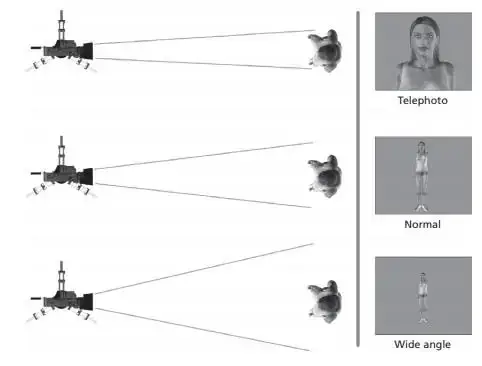Best Canon lenses for Filmmaking – A Complete Guide

In this article, we will look at the best Canon lenses for filmmaking. Choosing a lens usually depends on the project we want to shoot. As you probably already know, we know 2 types of lenses – prime lenses and zoom lenses. Prime lenses are well known for their super-sharp focus and low cost, while zoom lenses are known for their flexibility and higher cost due to the higher manufacturing complexity of the lens. Prime lenses have a fixed focal range while zoom lenses have a variable focal range.
The focal range is closely connected to the field of view we are able to capture with our camera. In the picture below you can see, that with a wide angle lens – short focal range (35mm or shorter) – we are able to capture a wider angle of view, than with a telephoto lens – long focal range (85mm or longer).

Certain focal lengths are ideal for certain projects.
The ideal focal range for landscape photography is 35mm or shorter – this gives us a wider angle of view and allows us to capture as much of the scenary as possible.
Normal lenses are lenses with a focal range of 50mm are the most common ones. It simulates the human eye better than any other lens, and it’s been the preferred lens for filmmakers from every genre. It’s really easy to make a 50mm lens with great optical quality and a huge maximum aperture—and do it very cheaply. It’s pretty common for lens makers to sell a fast 50mm f/1.8 lens, with crisp high-contrast image quality, for the cost of a nice dinner for two on the town.
Telephoto lenses are essentially telescopes for your camera. They let you narrow down the field of view to photograph distant scenes. Telephotos come in a variety of lengths, ranging from 85 to 135mm lenses suited for portrait shots in a studio. The convention is to use a short telephoto, which has a focal length of at least 85mm on a full-frame camera. This focal length gives you a flattering perspective when shooting someone’s head and shoulders. Generally, 85mm, 100mm, and 135mm are popular portrait lenses. When using a subframe sensor camera, you can go for slightly shorter lenses, such as 50mm through 85mm.
Super-telephoto lenses have a folcal range of 200mm and longer and are ideal for that perfect shot of a lion stalking across the savanna or close-up photos.
As a professional filmmaker, you will need at least 2 prime lenses and 1 zoom lens. The 2 prime lens focal ranges I would recommend are 28mm, 50mm. With these two you will be able to take up any scene, be it wide or narrow. Keep in mind that prime lenses do a great job when the subjects are not moving relative to the camera. For added flexibility and close-up shots, every filmmaker should own at least one zoom lens.
What are the Best Prime Canon lenses for Filmmaking?
I’ve chosen 2 Prime Canon lenses, one with a wide angle lens, and the second one with a medium telephoto lens.
Canon EF 28mm f/1.8 USM Wide Angle Lens for Canon, Fixed Lens
This is a wide-angle lens, with a short focal range of 28mm. The lens is ideal for shooting a scene where we want to capture as much of the environment where the subject is currently situated. This allows our viewers to acquire more information about the scene. These kinds of scenes are usually at the beginning of each sequence of the film, in order to give the viewer some information about the current setting.
This lens is well made, the ultrasonic focus is silent and very fast, which makes it a perfect lens for recording videos. It’s 1.8 USM aperture is silent and extremely fast. Autofocus is great in low light. Plus the 28mm is more suitable for crop sensors. This lens does not have the “hot spot” issues like the 50mm 1.8 does on the IR camera. Hotspots are still possible but rare and subtle. Due to it’s wide aperture, you might never need to use a flash. This is, in my humble opinion, the best Canon prime lenses for filmmaking.
- Measures 2.7 inches in diameter and 1.7 inches long , weighs 6.5 ounces.This lens takes a 58mm filter.
- Focal length: 28mm, Closest focusing distance: 1 foot
- Broadens angle of view and increases depth of field to bring more area into focus
- 28mm wide-angle lens with f/1.8 maximum aperture for Canon SLR cameras.Max. Diameter x Length, Weight:2.9 x 2.2, 10.9 oz. / 73.6 x 55.6mm, 310g
- High-precision aspherical lens minimizes distortion and other aberrations; Refer user manual under technical specification for troublr shooting steps
Canon EF 50mm f/1.4 USM Standard and Medium Telephoto Lens for Canon, Fixed Lens
The second prime lens everybody should own is a medium telephoto lens. It’s focal length of 50mm resembles our human eye, and is commonly used in cinematography. The lens can be used to shoot scenes where we would like to capture a conversation between 2 or more people and allows us to create intimacy between the view and the actors.
I think the 50mm f/1.8 is perfectly fine and will produce great photos. However, if you’re ready to up your photography game, the f/1.4 really takes it there. This lens is especially great for portrait-type pictures because it creates a sharp focus complimented by a nice bokeh or blurry background.
- Standard focal length 50 millimeter lens is effective in a multitude of shooting situations and ideal for day-to-day shooting
- Elements, Groups: 7 by 6, Diaphragm: Blades 8, Filter Thread: Font 58 millimeter. Minimum focusing distance: 17.8 inch
- An f 1.4 maximum aperture provides clear imaging in low light situations and shallow depth of field
- Ultrasonic autofocus motor (USM) operation is fast, smooth and virtually silent
- 2 high-refraction lens elements and new Gaussian optics eliminate astigmatism and suppress astigmatic difference
What is the Best Zoom Canon lenses for Filmmaking?
A zoom lens is also an important part of a filmmaker’s kit. The lens gives a lot of flexibility and also allows the filmmaker to create some interesting film effects, like the dolly zoom.
Canon 70-200mm F/4L EF is USM Telephoto Lens for Canon, Zoom Lens
This lens is a great alternative to a more expensive lens version ($2000+) with an F2.8 aperture. This lens does not come with image stabilization and its maximum aperture is not that wide open, but it will do an amazing job at taking photos provided there is enough light in the environment. For the price below $1000 this is a very very good option. I would consider this zoom lens to be up there with the already mentioned Tamron 70-180mm F/2.8 if shot in an environment with enough light. For those of you who use a Canon camera system this lens would be the best canon budget zoom lens. This is the best Canon zoom lenses for filmmaking
- Please see the above description.
- German (Publication Language)
Final Thoughts
In this guide, I’ve recommended 2 prime lenses with focal lengths of 28mm and 50mm. These 2, in my opinion, are the musta have lenses, but let nothing stop you from expanding your arsenal. Prime lenses with a focal range of 35mm or 80mm are also a very good choice if you want that crisp sharp scenes no matter the distance to your subject. But if you are not yet ready to expand your arsenal with additional prime lenses, your zoom camera will have you covered for all the focal lengths you might desire.
I hope you found my guide useful and I wish you tons of Hollywood grade videos with your new lenses ?.


